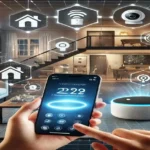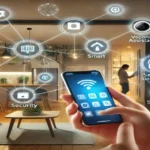In today’s digital age, our homes are becoming increasingly interconnected through smart home devices. These gadgets offer unparalleled convenience, allowing us to control everything from lighting to security systems with a simple voice command or a tap on our smartphones. However, with this convenience comes the pressing need for robust security and awareness to protect our homes from potential cyber threats.
The Rise of Smart Homes
Imagine coming home after a long day, and as you approach your front door, it unlocks automatically. The lights turn on to your preferred brightness, and your favorite music starts playing in the background. This isn’t a scene from a futuristic movie; it’s the reality that smart home technology offers today.
According to recent statistics, the adoption of smart home devices has seen exponential growth. In 2024, approximately 69.91 million U.S. households were actively using these devices, with the market projected to reach $250.6 billion by 2029. This surge is driven by the desire for enhanced convenience, energy efficiency, and improved home security.
The Dark Side: Potential Vulnerabilities
While the benefits are enticing, it’s crucial to be aware of the potential risks associated with integrating smart devices into our homes. A recent incident reported by the New York Post highlighted a chilling scenario where a mother heard a stranger’s voice speaking to her son through a Wi-Fi-enabled baby monitor. This intrusion left the family feeling vulnerable and exposed, underscoring the importance of securing our smart home devices.
Common Vulnerabilities in Smart Home Devices
- Weak Passwords and Default Settings: Many devices come with default credentials that users often neglect to change, making it easy for hackers to gain unauthorized access.
- Outdated Firmware: Manufacturers regularly release updates to patch security flaws. However, if users don’t update their devices, they remain susceptible to known vulnerabilities.
- Insecure Communication Protocols: Some devices transmit data without proper encryption, allowing cybercriminals to intercept and manipulate information.
- Third-Party Integrations: Connecting third-party apps or services can introduce additional vulnerabilities, especially if they lack robust security measures.
Real-Life Implications of Insecure Devices
Consider the case of Sarah and her family. They were thrilled with their new smart home setup, enjoying the convenience of controlling their home’s features remotely. However, their excitement turned to alarm when they noticed their smart thermostat adjusting itself unexpectedly. The situation escalated when a stranger’s voice emanated from their baby monitor, describing their child’s room in detail. This harrowing experience highlighted the potential dangers of unsecured smart devices and the paramount importance of implementing stringent security measures.
Steps to Secure Your Smart Home
Ensuring the security of your smart home doesn’t have to be daunting. By following these actionable steps, you can significantly reduce potential risks:
1. Change Default Passwords Immediately
Upon installing a new device, always change the default password to a strong, unique one. Avoid using easily guessable information like “password123” or “admin.” Instead, opt for complex combinations of letters, numbers, and special characters.
2. Regularly Update Firmware
Manufacturers frequently release firmware updates to address security vulnerabilities. Regularly check for updates and install them promptly to keep your devices protected.
3. Secure Your Home Network
Your Wi-Fi network serves as the gateway to all your connected devices. Ensure it’s secured by:
- Using strong, unique passwords.
- Enabling network encryption (WPA3 is recommended).
- Setting up a guest network for visitors to prevent them from accessing your main devices.
4. Disable Unnecessary Features
Many devices come with features that you might not use, such as remote access or voice control. If they’re not essential, consider disabling them to minimize potential entry points for hackers.
5. Be Cautious with Third-Party Integrations
While third-party apps can enhance functionality, they can also introduce vulnerabilities. Only integrate trusted applications and regularly review the permissions you’ve granted.
6. Monitor Device Activity
Regularly monitor your devices for unusual activity. Unexpected behavior, such as devices turning on or off by themselves, could indicate unauthorized access.
7. Educate Household Members
Ensure that everyone in your household understands the importance of smart home security. Regularly discuss best practices and stay informed about potential threats.
The Role of Manufacturers and Legislation
While users play a crucial role in securing their devices, manufacturers and governments also bear responsibility. Recently, concerns have been raised about the security of devices containing components from certain countries. For instance, an article from the Financial Times highlighted warnings about Chinese-manufactured electronics in everyday devices, which could pose significant cyber threats. This underscores the need for stringent manufacturing standards and robust cybersecurity measures.
Conclusion
The integration of smart home devices into our daily lives offers unparalleled convenience and efficiency. However, it’s imperative to approach this technological advancement with a keen awareness of potential security risks. By proactively implementing the steps outlined above and staying informed about emerging threats, you can enjoy the benefits of a smart home while safeguarding your privacy and security.
Frequently Asked Questions (FAQs)
Q1: How can I tell if my smart home device has been hacked?
A1: Signs of a compromised device include unusual behavior, such as unexpected changes in settings, devices operating on their own, or unfamiliar voices or sounds. Regularly monitoring your devices and network can help detect unauthorized access early.
Q2: Are all smart home devices vulnerable to hacking?
A2: While not all devices are equally vulnerable, any device connected to the internet carries some risk. Factors such as weak passwords, outdated firmware, and insecure network configurations can increase vulnerability.
Q3: How often should I update my smart home devices?
A3: It’s advisable to check for firmware updates at least once a month. Enable automatic updates if the device supports it, ensuring you receive security patches promptly.
Q4: Is it safe to use public Wi-Fi to control my smart home devices?
A4: Accessing your smart home devices over public Wi-Fi is not recommended, as these networks are often unsecured. If necessary, use a Virtual Private Network (VPN) to encrypt your connection.
Q5: What should I do if I suspect my smart home device has been compromised?
A5: Immediately disconnect the device from your network, reset it to factory settings, and change all associated passwords. Ensure your router and other devices are secure, and consider consulting a cybersecurity professional for further assistance.
By staying vigilant and proactive, you can enjoy the myriad benefits of smart home technology while keeping potential threats at bay.



